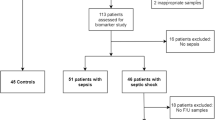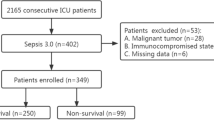Abstract
The objective of the study was to determine the accuracy of phospholipase A2 group II (PLA2-II), interferon-gamma-inducible protein 10 (IP-10), angiopoietin-2 (Ang-2), and procalcitonin (PCT) plasma levels in early ruling in/out of sepsis among systemic inflammatory response syndrome (SIRS) patients. Biomarker levels were determined in 80 SIRS patients during the first 4 h of admission to the medical ward. The final diagnosis of sepsis or non-infective SIRS was issued according to good clinical practice. Sensitivity, specificity, positive predictive value (PPV) and negative predictive value (NPV) for sepsis diagnosis were assessed. The optimal biomarker combinations with clinical variables were investigated by logistic regression and decision tree (CART). PLA2-II, IP-10 and PCT, but not Ang-2, were significantly higher in septic (n = 60) than in non-infective SIRS (n = 20) patients (P ≤ 0.001, 0.027, and 0.002, respectively). PLA2-II PPV and NPV were 88 and 86 %, respectively. The corresponding figures were 100 and 31 % for IP-10, and 93 and 35 % for PCT. Binary logistic regression model had 100 % PPV and NPV, while manual and software-generated CART reached an overall accuracy of 95 and 98 %, respectively, both with 100 % NPV. PLA2-II and IP-10 associated with clinical variables in regression or decision tree heterogeneous models may be valuable biomarkers for sepsis diagnosis in SIRS patients admitted to medical ward (MW). Further studies are needed to introduce them into clinical practice.



Similar content being viewed by others
References
Gaiesky D, Edwards M, Kallan M, Brendan GC (2001) Benchmarking the incidence and mortality of severe sepsis in the United States: epidemiology of severe sepsis in the United States: analysis of incidence, outcome, and associated costs of care. Crit Care Med 329:1303–1310
Martin GS , Mannino DM, Eaton S, Moss M (2003) The epidemiology of sepsis in the United States from 1979 through 2000. N Engl J Med 348:1546–54
Rivers E, Nguyen B, Havstad S, Ressler J, Muzzin A, Knoblich B, Peterson E, Tomlanovich M (2001) Early goal-directed therapy in the treatment of severe sepsis and septic shock. N Engl J Med 345(19):1368–77
Kumar A, Roberts D, Wood KE, Light B, Parrillo E, Sharma S, Suppes R, Feinstein D, Zanotti S, Taiberg L, Gurka D, Kumar A, Cheang M (2006) Duration of hypotension before initiation of effective antimicrobial therapy is the critical determinant of survival in human septic shock. Crit Care Med 34:1589–1596
Buisson CB, Roudot-Thoraval F, Girou E, Grenier-Sennelienr C, Durand-Zaleski I (2003) The costs of septic syndromes in the intensive care unit and influence of hospital acquired sepsis. Intensive Care Med 29:1464–1471
Pierrakos C, Vincent JL (2010) Sepsis biomarkers: a review. Crit Care 14:R15
Levy M, Artigas A, Phillips G, Rhodes A, Beale R, Osborn T, Vincent JL, Townsend S, Lemesow S, Dellinger P (2012) Outcomes of the surviving sepsis campaign in intensive care units in the USA and Europe: a prospective cohort study. Lancet Infect Dis 12:919–924
Bone RC, Balk RA, Cerra FB, Dellinger RP, Fein AM, Knaus WA, Schein RM, Sibbald WJ (1992) Definitions for sepsis and organ failure and guidelines for the use of innovative therapies in sepsis. The ACCP/SCCM Consensus Conference Committee. American College of Chest Physician/Society of Critical Care Medicine. Chest 101:1644–1655
Dellinger RP, Levy MM, Rhodes A, Annane D, Gerlach H, Opal SM, Sevransky JE, Sprung CL, Douglas IS, Jaeschke R, Osborn TM, Nunnally ME, Townsend SR, Reinhart K, Kleinpell RM, Angus DC, Deutschman CS, Machado FR, Rubenfeld GD, Webb S, Beale RJ, Vincent JL, Moreno R, Surviving Sepsis Campaign Guidelines Committee including The Pediatric Subgroup (2013) Surviving Sepsis Campaign: international guidelines for management of severe sepsis and septic shock, 2012. Intensive Care Med 39(2):165–228
Muller R, Mockerl M (2008) Logistic regression and CART analysis in the analysis of multimarker studies. Clin Chim Acta 394:1–6
Coeh J, Opal S, Calandra T (2012) Sepsis studies need new direction. Lancet 12:503–504
Rintala EM, Aittoniemi J, Laine S, Nevalainen TJ, Nikoskelainen J (2001) Early identification of bacteremia by biochemical markers of systemic inflammation. Scand J Clin Lab Invest 61:523–530
Rintala Esa M, Nevalsinen TImo J (1993) Group II phospholipase A2 in sera of febrile patients with microbiologically or clinically documented infections. Clin Infect Dis 17:864–870
Punyadeera C, Schneider EM, Schaffer D, Hsu HY, Joos TO, Kriebel F, Weiss M, Verhaegh WF (2010) A biomarker panel to discriminate between systemic inflammatory response syndrome and sepsis and sepsis severity. J Emerg Trauma Shock 3:26–35
Ng PC, Li K, Chui KM, Leung TF, Wong RP, Chu WC, Wong E, Fok TF (2007) IP-10 is an early diagnostic marker for identification of late-onset bacterial infection in preterm infants. Pediatr Res 61:93–98
Magrini L, Travaglino F, Marino R, Ferri E, De Berardinis B, Cardelli P, Salerno G, Di Somma S (2013) Procalcitonin variations after Emergency Department admission are highly predictive of hospital mortality in patients with acute infectious diseases. Eur Rev Med Pharmacol Sci 17(Suppl 1):133–142
Su L, Han B, Liu C, Liang L, Jiang Z, Deng J, Yan P, Jia Y, Feng D, Xie L (2012) Value of soluble TREM-1, procalcitonin, and C-reactive protein serum levels as biomarkers for detecting bacteremia among sepsis patients with new fever in intensive care units: a prospective cohort study. BMC Infect Dis 12:157
Gibot S, Be´ne´ MC, Noel R, Massin F, Guy J, Cravoisy A, Barraud D, De Carvalho Bittencourt M, Quenot JP, Bollaert PE, Faure G, Charles PE (2012) Combination biomarkers to diagnose sepsis in the critically ill patient. Am J Respir Crit Care Med 186:65–71
Casserly B, Read R, Levy MM (2011) Multimarker panels in sepsis. Crit Care Clin 27:391–405
Wong HR, Cvijanovich NZ, Hall M, Allen GL, Thomas NJ, Freishtat RJ, Anas N, Meyer K, Checchia PA, Lin R, Bingham MT, Sen A, Nowak J, Quasney M, Henricksen JW, Chopra A, Banschbach S, Beckman E, Harmon K, Lahni P, Shanley TP (2012) Interleukin- 27 is a novel candidate diagnostic biomarker for bacterial infection in critically ill children. Crit Care 16:R213
Sankar V, Webster NR (2012) Clinical application of sepsis biomarkers. J Anesth 27:269–283
Zhao H, Heard SO, Mullen MT, Crawford S, Goldberg RJ, Frendl G, Lilly CM (2012) An evaluation of the diagnostic accuracy of the 1991 American College of Chest Physicians/Society of Critical Care Medicine and the 2001 Society of Critical Care Medicine/European Society of Intensive Care Medicine/American College of Chest Physicians/American Thoracic Society/Surgical Infection Society sepsis definition. Crit Care Med 40:1700–1706
Lin RY, Nuruzzaman F, Shah SN (2009) Incidence and impact of adverse effects to antibiotics in hospitalized adults with pneumonia. J Hosp Med. 4(2):E7–E15
Acknowledgments
We are indebted to Paola Pitacco and Ilaria De Fabris for their excellent technical support. The study has been supported by SIRS group: De Grassi Selene, De Roia Marina, Iudicello Alessandra, Lombardi Jacopo, Marizza Silvia, Montanari Giulia, Nigro Antonella, Paoli Irene, Peric Daniele, Stefanucci Tommaso, Valentini Denis.
Conflict of interest
None.
Author information
Authors and Affiliations
Corresponding author
Rights and permissions
About this article
Cite this article
Mearelli, F., Fiotti, N., Altamura, N. et al. Heterogeneous models for an early discrimination between sepsis and non-infective SIRS in medical ward patients: a pilot study. Intern Emerg Med 9, 749–757 (2014). https://doi.org/10.1007/s11739-013-1031-x
Received:
Accepted:
Published:
Issue Date:
DOI: https://doi.org/10.1007/s11739-013-1031-x




